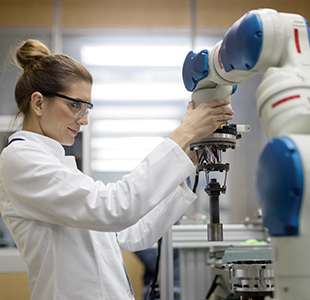
Casual observers looking for robots in clinical laboratories might miss them on first glance. That’s because today’s robots look nothing like the helpful and enterprising humanoid C-3PO character from the Star Wars movie franchise. Even without designs inspired by the human body, these small and nimble machines are taking the most repetitive laboratory tasks out of human hands, and they’re about to be everywhere.
ABB Robotics, a robotics manufacturer that runs a new research center at the Texas Medical Center (TMC) Innovation Institute in Houston, estimates that the market for nonsurgical robots in healthcare will reach 60,000 by 2025, a fourfold increase from 2018. Of those, the firm expects 5,000 to be for laboratories.
This influx of robot assistants doesn’t mean humans will be banished, said Jose Manuel Collados, healthcare solutions business line manager at ABB Robotics. “We really see robots supporting in dangerous or dull activities. We are focused on supporting people,” he said.
Here’s how robots are being used right now.
The Robotics You Already (Should) Know
Robotic elements in laboratory medicine are not new. However, much of this technology has advanced rapidly in the last few years, while staying inside larger instrument and track systems that have disguised its evolution.
In about the year 1990, clinical
laboratory professionals started hearing about “total laboratory automation,” said Robin Felder, PhD, professor of pathology and associate director of clinical chemistry and toxicology at the University of Virginia School of Medicine in Charlottesville. But this hoped-for eventuality hasn’t quite happened, at least not yet.
Right now, robotics most often are used to “organize the most routine and repetitive part of the laboratory,” he said: things like centrifuging, aliquoting, and automating routine chemistry, immunoassay, hematology, and urinalysis. The systems are most often enabled by bar codes that tell robotic elements within various instruments what to do.
“But if it wasn’t routine and it wasn’t high volume, then there was a special place in the lab where people still did things like feed analyzers manually,” said Felder. That’s changing as robots are “beginning to swallow up all of the manual parts of the laboratory.”
This is possible because robotic technology is getting more sophisticated, more accurate, and more intelligent as artificial intelligence (AI) becomes part of the picture. Robotic technology also is cheaper now, with price points that make financial sense when it saves labs money on other operational expenses. For example, a robotic arm not only can process more tests without fatiguing, but also handle tinier amounts of liquid, far less than a person could.
“There’s a bonus of using smaller and smaller volumes in that reagent costs so much per volume, and if you’re using a quarter or one-tenth the amount of reagent, you’re saving that much money on costs for raw materials,” Felder said. “Robots can handle those small volumes.”
A robot also makes fewer mistakes, said Abd Al-Roof Higazi, PhD, head of the department of biochemistry and divisions of laboratories at the Hadassah Medical Center in Jerusalem. Higazi’s lab recently installed the Siemens Atellica Solution, which integrates immunoassay and clinical chemistry analyzers with sample-management technology. This system processes 95% of the lab’s tests, Higazi said, about 600 samples an hour or about 4 million a year. “These analyzers are more sophisticated than airplanes,” he added.
Higazi has been using the current system for about a year. “The tube will arrive in the lab, and the machine will read the bar code and know what to do with the tube,” he said. After tests are run, the tubes are archived and refrigerated for several days in case physicians order more tests. If not, they are discarded.
“Nobody has to touch the tube, and all of this is done automatically and robotically,” said Higazi. The system is “not only so much quicker, but we also have almost no errors.” Results for some tests come within minutes.
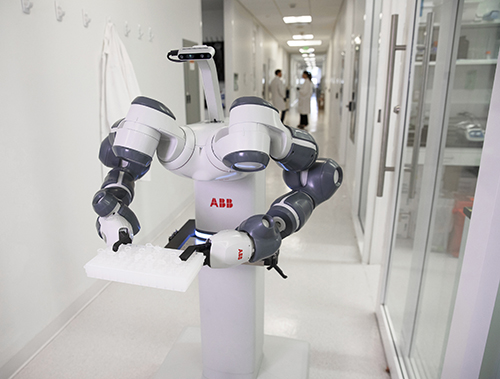
Robots Step Out of the Analyzer
ABB Robotics opened its TMC research hub in October 2019. The institute showcases a number of concept technologies, including the YuMi robot.
While it’s not quite Rosey, the robot maid from the Jetsons cartoon series, YuMi also is not entirely unrecognizable. This collaborator robot has arms with grippers to help scientists work. Instead of being cloaked inside the workings of a larger instrument, YuMi is a step toward the somewhat humanoid, more independent entities that the word “robot” might conjure.
YuMi has a lot of possibilities for patient care—bringing medical supplies to hospital staff and bed linens directly to patients—but also offers laboratories the opportunity to integrate this technology into a device to take over time-consuming activities like dosing, mixing, and pipetting tasks, and loading and unloading centrifuges.
“A primary goal across TMC—the largest medical city in the world—is to make research happen faster while simultaneously cutting costs in order to create more rapid and cost-effective solutions for patients who are in desperate need of treatment,” said Bill McKeon, president and CEO of TMC, in a statement.
In addition to TMC, the European Institute of Oncology has integrated YuMi into its labs to help staff manage steps in immunoassay testing for viral antigens. Copan Diagnostics is also using a YuMi-based HEPA filtered biosafety workstation to manage tissue, bone, and sterile fluid samples, and to transport swabs and blood cultures.
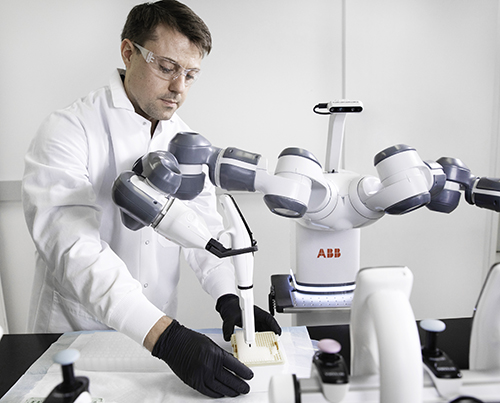
Robots in Their Own Labs, With Direction in the Cloud
Already in a few cases, humans are now in the minority within labs, supporting robots rather than the other way around. At Strateos, an on-demand, remote-access laboratory for life science research and drug discovery, lab work is primarily done through the cloud. This means researchers from around the world can log in to a secure portal from a desktop computer, program the robots (which are supported by a few human helping hands) in Strateos’ warehouses to run their tests, then access the results through Amazon Web Services (AWS), an on-demand cloud computing platform.
Ben Miles, PhD, head of product at Strateos, said that AWS “has certainly given us a leg up on building a lot of security and how we capture all that data and securely get it back to users efficiently at scale.”
In the most ideal conditions, depending on the process and workflow, Strateos’ robots can run 190,000 experiments a day. “With robotics, it’s extremely easy to repeat process protocols, workflows, things like that,” said Miles. “It’s software that can easily be rerun and shared and built upon.”
The company’s primary focus has been in the preclinical space and on small molecule drug discovery, but it plans to launch synthetic chemistry analysis by the end of 2020. “There’s been a collaboration in the works with COVID testing of patient samples,” said Miles.
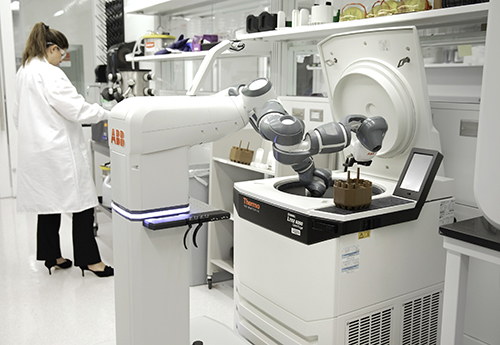
The Human Element
Where do people fit in this new future? It depends on how far the technology goes, experts said. ABB’s Collados doesn’t see the continual integration of robots as ending the human element in healthcare, especially for clinical laboratories. “Labs are not a factory; it’s a very different environment,” he said. “Robots will free up the time of lab technicians to take on other tasks.”
Robots handling repetitive lab processes can also enable greater collaboration, said Miles. He sees Strateos as an opportunity to “create one giant scientific platform that’s accessible from anywhere around the planet,” he said. “If it was in Germany and you’re on the East Coast, we can both be collaborating on an experiment in the cloud together,” he said. “I also think the scale of data is just going to be enormous once you can start aggregating all of it.”
In the future, Miles also believes AI will allow the robots to start building on this data and running their own experiments, thus further pushing science forward.
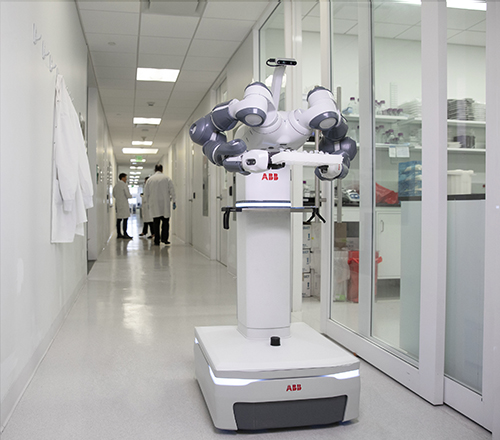
Jen A. Miller is a freelance journalist who lives in Audubon, New Jersey.
+TWITTER: @byJenAMiller